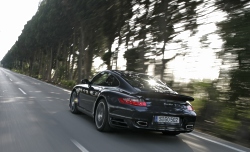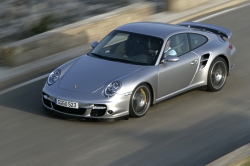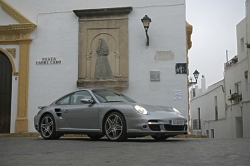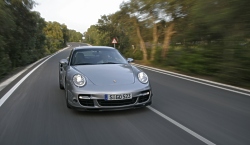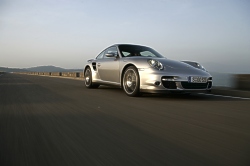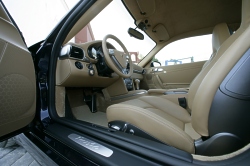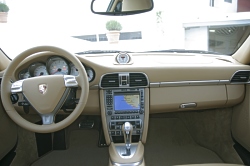
![]()
.
![]()
![]()
![]()
![]()
.
.
![]()
![]()
![]()
![]()
![]()
..
![]()
.
.
.
.

911 Turbo
© 1999-2004
Copyright
Automotive Intelligence,
www.autointell.com
All Rights Reserved .
For questions please contact
editor@autointell.com
.
|
. |
Porsche : Porsche 911 Turbo

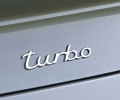

The term "Turbo" is a synonym for truly outstanding performance and driving dynamics. And precisely these exceptional qualities have been enhanced time and again by ongoing technical development ever since Porsche presented the first 911 Turbo in 1974.
Now the new Turbo raises the benchmark to an even higher level. Offering a truly cutting-edge package of new, innovative technology features, the new Porsche 911 Turbo sets an unprecedented benchmark in driving dynamics. The key elements of this package are the two turbochargers for the first time featuring variable turbine geometry (VTG) as well as Porsche's newly developed and fully controlled four-wheel-drive PTM Porsche Traction Management.
Interacting efficiently with one another, these two systems offer the driver a new world of performance even more dynamic performance than before: Accelerating all-out with an optimum six-speed manual gearshift, the new 911 Turbo reaches 100 km/h in just 3.9 seconds and hits the 160 km/h-mark within 8.4 seconds.
|
And even this is not all, since the combination of new turbocharger technology and Porsche Traction Management with the newly set-up Tiptronic S makes the car's acceleration even faster: Fitted with optional Tiptronic transmission, the new 911 Turbo accelerates to 100 km/h in a staggering 3.7 seconds. |
Top speed with both types of transmission, finally, is 310 km/h or 192 mph.
|
Dynamic looks The new 911 Turbo comes right at the top of the 911 model series not only on account of its supreme performance. The exterior design of the car is also a lot more sporting and dynamic than that of the former model, at the same time clearly revealing that this top-permance athlete is a full member of the new 911 Series: Strikingly chiselled intake air scoops with integrated LED direction indicators and foglamps moved far to the outside give the front end a unique, characteristic look. The rear end, in turn, now exudes an even more distinctive impression of power thanks to the wheel arches widened by 22 millimetres or 0.87" and the tailpipes moved higher up than before. The side air intakes behind the doors have also been re-designed, again contributing to the special character of the 911 Turbo. Significant progress in technology: turbocharger with variable turbine geometry The supreme performance of the car is attributable in particular to the newly developed turbocharger technology boasted on the six-cylinder power unit: Using special materials extremely resistant to high temperatures, Porsche's engineers have succeeded in developing an exhaust gas turbocharger with variable turbine geometry (VTG) able to withstand very high exhaust gas temperatures of up to 1000°C or 1830°F also on a gasoline engine. |
So now one turbocharger with variable turbine geometry offers the advantages of both a small and a large turbocharger all in one. In practice, this means that the two turbines featured for the first time as a team are able to use exhaust energy at all times and under all operating conditions for an optimum boost effect.
The result of this new technology is a significant increase in both power and torque: Maximum output of the flat-six power unit is now 353 kW (480 bhp) at 6000 rpm, 44 kW or 60 bhp more than on the former model - and this is despite engine capacity remaining unchanged at exactly 3.6 litres. Peak torque, in turn, is up from 560 to 620 Newton-metres (413 - 457 lb-ft) throughout a far wider speed range, the new Turbo maintaining its peak torque consistently all the way between 1950 and 5000 rpm and showing a much better response than an engine with a conventional turbocharger.
Overboost for even faster acceleration
As an option the new 911 Turbo is available with the Sports Chrono Package Turbo including Overboost as one of its special features for even faster acceleration: Pressing the Sports button, the driver is able to boost turbocharger pressure in the medium speed range briefly by approximately 0.2 bar, increasing torque by another 60 to 680 Newton-metres or 501 lb-ft in the interest of even faster acceleration and extra flexibility. In this case the 911 Turbo accelerates from 80 - 120 km/h (50 - 75 mph) in its second-highest gear in just 3.5 instead of 3.8 seconds (manual) or, respectively, in an even more impressive 3.3 instead of 3.5 seconds (Tiptronic S).
New all-wheel-drive management in a Porsche sports car
The new 911 Turbo combines more torque and more power with a significant improvement of power transmission ensured by new management of the car's four-wheel drive: Featured as standard, PTM Porsche Traction Management combines driving pleasure typical of Porsche offered by the engine mounted at the rear and rear-wheel drive with even greater driving stability, traction, and agile handling. To achieve this superiority, PTM transmits exactly the right percentage of engine power to the front wheels in each situation via an electromagcally controlled multiple-plate clutch. Operating within 100 milliseconds at the very most, PTM responds more quickly than the engine to a change in load and more quickly than even the driver himself will ever notice. It is fair to say, therefore, that Porsche four-wheel drive is able to literally "look ahead". On the road this means superior agility on narrow country lanes, excellent traction and a high standard of all-round safety even in extreme driving manoeuvres at high speeds and on wet or snow-bound surfaces.
Safe driving dynamics with PSM and an optional limited-slip differential
In the new 911 Turbo PTM Porsche Traction Management communicates directly with PSM Porsche Stability Management also featured as standard. A further important benefit is that Stability Management is now supplemented by enhanced brake functions, pre-loading of the brake system serving to further shorten stopping distances when applying the brakes all-out. And should the driver apply the brakes quickly, but not with full force, the Brake Assistant is activated and the hydraulic pump serves to build up full brake pressure for ABS brake action on all four wheels. As an option, Porsche also offers the genuine enthusiast a mechanical rear axle wheel lock with asymmetric distribution of engine power further enhancing the driving dynamics of the fully controlled Porsche Traction Management all-wheel-drive system.
Superior brake performance with optional ceramic brakes
Following Porsche's straightforward safety philosophy, an increase in engine power always requires an appropriate increase in brake power. Precisely this is why the front wheels now come with six-piston fixed-calliper brakes increasing the brake lining area by no less than 42 per cent. Diameter of the inner-vented brake discs has also increased from 330 to 350 millimetres (13.00 - 13.78").
New aluminium doors for less weight
Yet a further special feature on the new 911 Turbo is the doors now made of aluminium, over and above the light-alloy front lid. Thanks to a special production technique, the doors offer the same safety in a collision as the steel doors on the Carrera models. But at the same time they weigh just 11 kilos or 24 lb, reducing the weight of the car in all by 14 kilos or 31 lb. So with its unladen weight of 1585 kg (3495 lb), the new Turbo, despite a wider range of equipment, is 5 kg lighter than its predecessor.
(May 8, 2006)
|
. |
.
.










